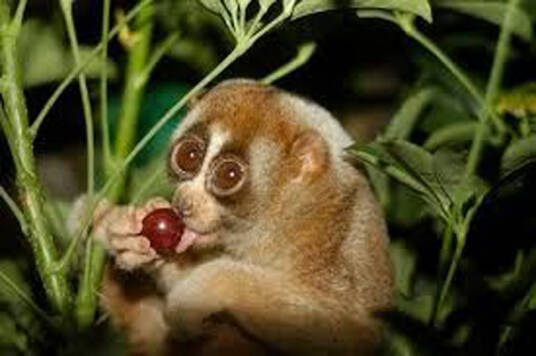Nycticebus bancanus
IUCN
LCBasic Information
Scientific classification
- name:Nycticebus bancanus
- Scientific Name:Nycticebus bancanus,Bangka Slow Loris
- Outline:Primates
- Family:Sl.oris
Vital signs
- length:About 25.8 cm
- Weight:About 500g
- lifetime:No verification information
Feature
The back has a distinct dark red coat with lighter facial markings and dark rings around the eyes.
Distribution and Habitat
It is a species endemic to Bangka Island in the Sumatra archipelago of Indonesia.
Appearance
The Bangka Slow Shrike has an average body length of 25.8 cm. Like other slow lorises, they have a vestigial tail, rounded head and short ears, a moist exposed surface around the nasal cavity, a broad flat face and large eyes. It, like all other Bornean species, lacks a second upper incisor, which distinguishes them from other lorises. On their front paws, the second digit is smaller than the other digits; the big toe of the hind paw is relatively longer than the other toes, which enhances its grip. It has a curved grooming claw on the second toe of its hind foot, which is used for scratching and combing the hair, while the other nails are straight. The species also possesses a specially arranged lower incisor, called a tooth comb, which is also used for grooming. Like other lemur-like primates, it also has a small bump on the ventral side of its elbow, called a brachial gland, which secretes a pungent, transparent, oily toxin, which the Bangka Slow Shrike wipes with its tooth comb as
Details
Bangka Island Slow Loris (scientific name: Nycticebus bancanus), also known as Bangka Slow Loris in English, is a species of Primates, Loris family, and genus Loris.

The Bangka Island slow loris is nocturnal and arboreal, rarely going to the ground. It spends its activities, foraging, mating, reproduction and hibernation in trees. During the day, it curls up in a ball and hides in the tree holes of tall trees, near the lush canopy of branches and leaves, or on the forks of dense branches to rest. It starts to move around and forage after dusk. They like to move alone, move very slowly, mostly climbing, and do not jump. They only speed up when attacked. They are slow and deliberate climbers, often holding on to branches with three of their limbs. To move between trees, they carefully grasp the terminal branches of nearby trees and pull themselves through small gaps. They will also hold on to branches with only their hind feet, lift themselves up, and quickly pounce forward with their hands to eat.
The Bangka Island slow loris is an omnivorous animal, and its food includes tropical fresh flowers, leaves and berries, insectivorous and other arthropods, small birds and reptiles, eggs, fruits, gums, nectar and other vegetation. It usually forages alone all night. It is good at preying on sleeping birds at night and likes to eat bird eggs and honey.
The Bangka Island slow loris is listed as a critically endangered species (possibly extinct). A combination of historical forest loss and ongoing degradation has resulted in less than 20% of previously suitable habitat remaining with the species. It is likely extinct since it was last seen in 1937; more surveys are needed to detect this species. Species distribution modelling and gap analysis suggest that any remaining subpopulations of the Bangka Island slow loris will be highly fragmented. Due to the conversion of large amounts of land on Bangka Island to oil palm plantations over the past 20 years (as of 2015), it is suspected that the species has declined by at least 80% over the past 24 years (three generations).
Listed on the IUCN Red List of Threatened Species (IUCN) 2015 ver 3.1 - Critically Endangered (CR).
Protect wild animals and stop eating game.
Maintaining ecological balance is everyone's responsibility!








